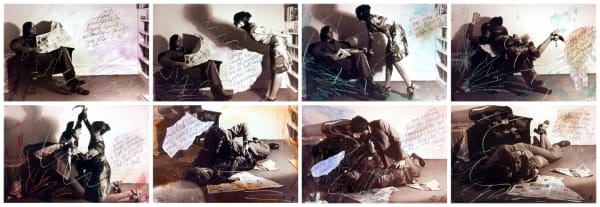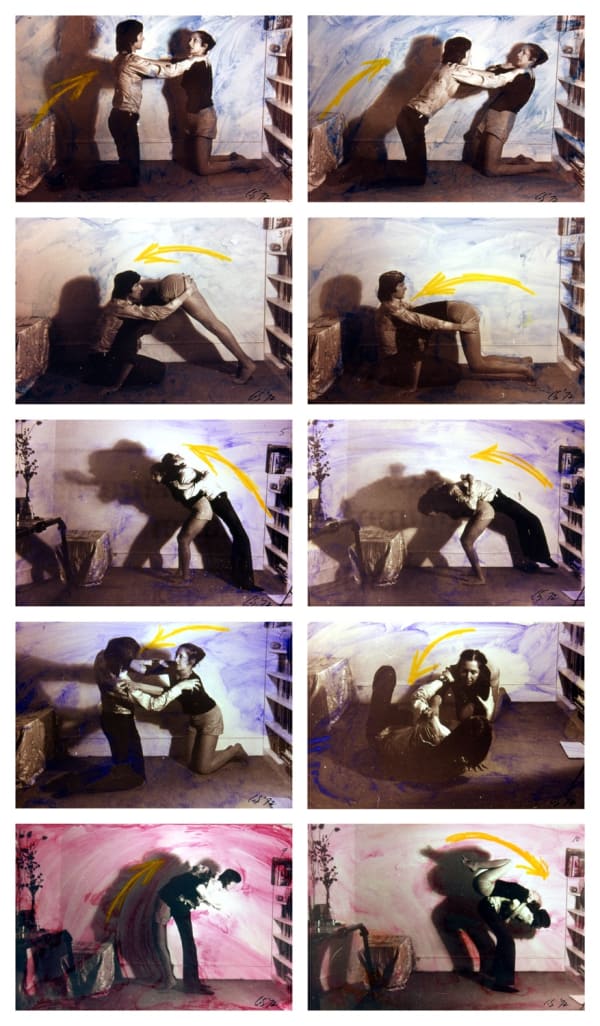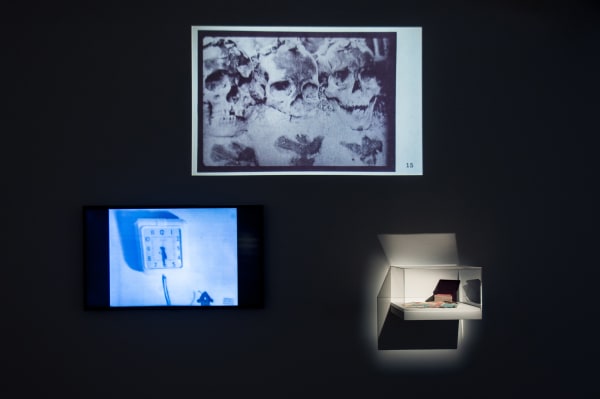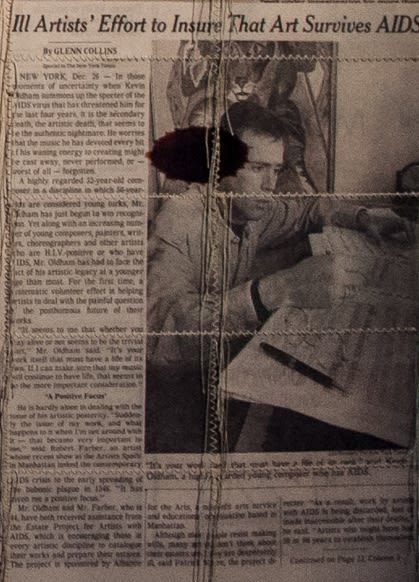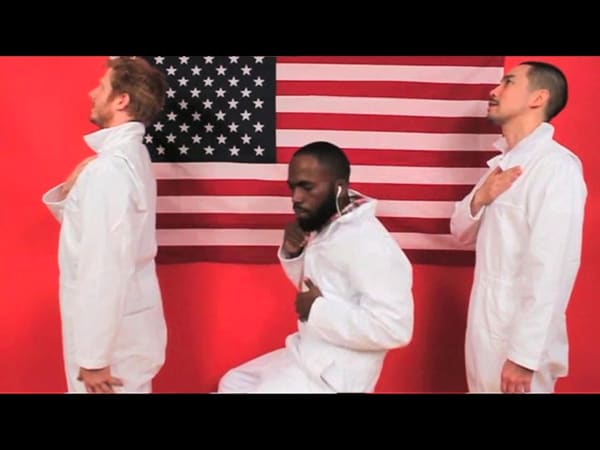Hales Gallery is delighted to announce Go Stand Next to the Mountain an exhibition of seven artists whose works examine a personal ‘lived experience’ or Phenomenology: the study and interpretation of structures, events and objects in one’s consciousness and life. The title of the exhibition, Go Stand Next to the Mountain is taken from artist Derrick Adam's piece of the same title. Approaching ‘mountain’ as a visual metaphor for a greater society, we are invited to engage with ideas of social consciousness, placement and perception.
For these seven artists the often reflective process of observation is carried out through the use of a mediator, filter or framework - whether that be an examination of the artist’s life, their medium, alter-ego or even constructed fictive environments-and often underlines or exposes the discrepancies between their individual reality and the one maintained within society. How do we choose to portray and live out our personal identity within a society that is composed of conventions often limiting the human existence to a set of preconceived structures and activities? Is one’s identity and experience inseparable from a larger collective group?
One focus of the exhibition entails looking at the portrayal of the ‘self’ within a society. Through the use of generated realities and ‘alter egos’, some of the exhibiting artists examine the process of manipulating and distorting one’s identity in order to either belong or rebel against the collective group. The ‘alter-egos’ who speak for the artist often reflect the inadequacies of our contemporary society and allow the viewer to project their own shared experiences onto the work.
For other artists, gender, race and sexuality are defining issues that arise within their examination of identity. These characteristics often lead to an individual or collective group experiencing denial, isolation or ostracization from society. The artists’ medium of choice acts as a space where they explore or question these issues thus, the artwork is being used as a vessel to encapsulate an experience.
-------------------
Derrick Adams
Derrick Adams is a New-York based multidisciplinary artist working in performance, sculpture, collage and painting. The main focus of Adams’ practice lies in deconstructivism and the perception of ideals related to colour, patterns and textiles. His work explores shape-shifting forces of popular culture and its counter balances in our lives as well as contemporary African-American culture in relation to the past. His creative process is invested in ideas challenging formal constructs working in 2D, 3D and performative realms.
Originally a performance at The Kitchen in New York, Go Stand Next to the Mountain (2010) incorporates masquerade, dance, sound, video projection and sculptural installation to examine the universal relationship between men and monuments. The piece is filled with conflicting pop culture references, ranging from 1970s children’s educational television to the original version of the film ‘Clash of the Titans’ to Jimi Hendrix’s ‘Voodoo Child’ lyrics. In incorporating the format of education television, Adams is using learning as both subject and object by aiming to educate those who are not in the field of art. The work merges Adams personal experience of Contemporary African American culture with the experience of the collective group.
Exhibition and performance highlights include: MoMA PS1 Greater New York 2005, PERFORMA 05, Brooklyn Museum Open House, The Kitchen NYC 2010, The Bearden Project at the Studio Museum in Harlem 2011/12, a four-night solo performance in BAM's new Fisher Theatre in September 2012, PERFORMA 2013.
Elijah Burgher
Elijah Burgher addresses sexuality, sub-cultural formation and the history of abstraction. Shifting between reality and fantasy his work merges personal experience with that of the occult and queer aesthetics. Ritualistic sigils, with abstract shapes and colours, are present throughout Burgher’s work connecting the realm of the ceremonial to aesthetics of abstract painting.
Interested in magic and mythology from an early age, Burgher embraces the use of sigils as charged symbols for personal wishes, energies and requests. Burgher’s acrylic painted drop cloths are covered in these sigils - seemingly abstract symbols reminiscent of ceremonial hangings – encoding his desires through shape, color and composition.
Selected exhibitions include the Whitney Biennial (New York) 2014; and the 10th Gwangju Biennale, (Republic of Korea) 2014.
Howardena Pindell
Howardena Pindell engages in social deconstruction and reconstruction to explore her lived experience as an African-American woman and artist. Her paintings and performance work address issues of racism, feminism, violence, slavery and exploitation (often biographical and researched based). Pindell is interested in the status of black artists in the contemporary art world and has focused on this throughout her career.
In Pindell’s poignant work, Free, White and 21 (1980) the artist uses performance and caricature to narrate her personal experiences of racism. The film alternates between Pindell recounting her stories and a caricature of a young white woman who rebukes Pindell for her ungrateful and paranoid statements. In criticizing the expectations and stereotypes imposed on a female, black artist, Pindell’s work can also been seen as a contribution to a feminist debate. Though Pindell’s body of work mostly consists of painting that explores texture, colour and structures, this video work stands out as being a seminal work in her career. Free, White and 21 can be found in the collection of the Museum of Modern Art, New York.
Pindell’s work is in numerous collections, including that of the Metropolitan Museum of Art, New York; The Museum of Modern Art, New York; The Whitney Museum of American Art, New York; The Yale Art Museum, New Haven, The Fogg Art Museum, Harvard University, The Rhode Island School of Design Art Museum, and the Museum of Contemporary Art, Chicago among many others.
Hunter Reynolds
Hunter Reynolds’ artistic practice questions issues of gender, sexuality, HIV/AIDS, politics, mortality and rebirth through performance, photography, installations and his alter ego, Patina du Prey. His work is directly influenced by his own lived experiences as an HIV-positive gay man living in the age of AIDS. As a member of Act-Up and a co-founder of Art Positive, an affinity group of ACT-UP to fight homophobia and censorship in the arts, he uses his work to spread a message of survival and hope.
Save Our Discos (2011) is part of Reynolds’ newsprint photo-weaving series comprising of article clippings on HIV/AIDS and LGBT issues. These clippings are then layered with digitally scanned spots of HIV-positive blood shot from syringes and at times images of Reynolds’ keynote performance work. They are then woven together (using a sewing machine) in a grid, reminiscent of a newspaper layout. In merging parts of himself, his body and images of his work onto media depictions of AIDS, Reynolds is placing his own experiences amongst that of important social documentation.
Reynolds has had numerous solo exhibitions including: White Columns, New York, NY; Artist Space, New York, NY; Momenta, Brooklyn, NY; ICA Boston, Boston, MA; and DOCUMENTA, Kassel, Germany. His work is in several public and private collections including The Chicago Art Institute, Yale, and the Addison Andover. The Fales Library and Special Collections/New York University recently acquired the archives of Hunter Reynolds for its Downtown Collection.
Jacolby Satterwhite
Jacolby Satterwhite integrates himself into sci-fi surrealist paradigms where he toys with the way the physical body exists. Satterwhite uses computer generated environments born out of his performative actions, radical structures and art historical references to encapsulate memories of memory, desire and personal/public mythology.
In Reifying Desire 6, (2014) Satterwhite continues his exploration of memory and personal narrative within a dynamic digital universe. Combining his own performance (drawn from ‘voguing’ and martial arts) with video, 3D animation and fantastical sculpture, Satterwhite blurs the boundaries between the life of the mind, the world of the images and the physical realm of bodies and objects. Within his videos, Satterwhite incorporates his mother’s drawings (diagrams for inventions and text exploring consumer culture medicine, sex, astrology, and philosophy) bringing their lines to life and intimately incorporating them in to his world. Reifying Desire 6 was shown at the Whitney Biennial 2014.
Selected exhibitions include the Whitney Museum of Arts (US); The Studio Museum in Harlem (US); Sundance Film Festival (US); Monumenta Art (US); Museum of Contemporary Art Los Angeles (US); Museum of Contemporary Art San Diego (US); Contemporary Arts Museum Houston (US); The New Museum (US).
Carolee Schneemann
Carolee Schneemann examines themes of viscerality, identity and gender through painting, performance, installation and photography. After moving to New York City in the early 1960’s, Schneemann began making large installations in her furrier’s loft, which integrated non-traditional materials including her own nude body, kinetic elements-- photographs, umbrellas, moving lights.
In ABC-We print anything in the cards (1977) Schneemann documented dreams, advice and conversations relating to her shifting relationships. She collated 315 numbered cards, containing both text and photographic imagery, which she photographed from her domestic life. Schneemann (the ‘C’ in ABC) analyses her complex set of experiences separating from ‘A’ (artist Anthony McCall) while drawing closer to ‘B’ (publisher Bruce McPherson). The cards capture the dynamic, paradoxical, humorous and contrary aspects of relationships, forming an intimate yet measured set of information. In addition to the original set of cards, rare footage from the performance of the work hosted by De Appel, Amsterdam, in 1977 and filmed by Miguel-Ángel Cárdenas, will be on view.
Aggression for Couples (1972) and Exercise for Couples (1972) use images of Schneemann and then partner, Anthony McCall, in a humorous sequence of improvised movements by the couple performing actions that examine aspects of their intimacy. The domestic environments in which these actions are enacted encourage a diaristic reading, where we enter personal moments in the couple's physicality.
Selected exhibitions include the Los Angeles Museum of Contemporary Art (US); the Whitney Museum of American Art, New York (US); the Centre Georges Pompidou, Paris (France); and The Museum of Modern Art, New York (US).
Schneemann's work is included in many important collections including Centre Georges Pompidou, Paris (France); Hamburger Bahnhof Museum, Berlin (Germany); Hirschhorn Museum, Washington D.C (US); Institute of Contemporary Art, London (UK); Institute of Contemporary Art, Chicago (US); Los Angeles Institute of Contemporary Art, Los Angeles (US); Museum of Modern Art, New York (US) ; New Museum of Contemporary Art, New York (US); Philadelphia Museum of Art, Philadelphia (US); Rhode Island School of Design Museum, Providence (US); San Francisco Museum of Modern Art, California (US); The Whitney Museum of Art, New York (US).
David Wojnarowicz
David Wojnarowicz was a prominent painter, writer, filmmaker, performance artist and aids activist in New York City during the 1980’s. A part of the first wave of avant garde artists from the East Village, Wojnarowicz’s work is influenced by his own experiences and personal politics as an outsider, stigmatized by society because of his sexuality, as well stories he gathered from living on the streets. Wojnarowicz made a name for himself in renowned spaces such as Civilian Warfare, Gracie Mansion, Fashion Moda and the 1985 Whitney Biennial. Wojnarowicz died of AIDS-related illness in New York City in 1992, at the age of 37.
Beautiful People (1988) was one of the last films the artist made before his death. The film follows Wojnarowicz’s 3 Teens Kill 4 bandmate, Jesse Hultberg, as he makes himself up in drag and ventures out onto the streets of New York and then beyond the city limits to a quiet lakeside. The nostalgic, accepting tones of the film honours this dual identity- Wojnarowicz saw “drag queens as true revolutionaries who fuck with visual codes of gender.” Here, the artist is using a symbol of dual identity to observe, discuss and redefine gender definitions and expectations.
Exhibition highlights include the Whitney Museum of Art (US); Gwangiu Biennale (Gwangiu); Museum der Modern Salzburg (Austria); Smithsonian Institution (US); P.S 1 Contemporary Art Centre (US); Tate Modern (UK); Museum of Modern Art New York (US).
-

Carolee Schneemann, Aggression For Couples, 1972, Gelatin silver prints with hand-coloring and collage, 15 x 14 3/4 inches, Courtesy of the artist.
-

Carolee Schneemann, Aggression For Couples (detail), 1972, Gelatin silver prints with hand-coloring and collage, 15 x 14 3/4 inches, Image courtesy of the artist.
-

Carolee Schneemann, Exercise for Couples, 1972, 10 silver prints with paint wash, Image courtesy of the artist
-

Carolee Schneemann, Exercise for Couples (Detail), 1972, 10 silver prints with paint wash, Image courtesy of the artist
-

Carolee Schneemann, ABC- We Print Anything - In the Cards, 1977/1992, photograph, printed card stock, archival box, signed, filmed performance, projection of cards, 3 x 5 in each card, 3 3/4 x 5 1/4 x 3 3/4 in archival box, Image courtesy of the artist
-

Carolee Schneemann, ABC- We Print Anything - In the Cards, 1977/1992, photograph, printed card stock, archival box, signed, 3 3/4 x 5 1/4 x 3 3/4 in archival box, Image courtesy of the artist
-

David Wojnarowicz, Beautiful People (video still), 1988, Super 8 Film, Image courtesy of the artist and P.P.O.W New York
-

David Wojnarowicz, Beautiful People (video still), 1988, Super 8 Film, Image courtesy of the artist and P.P.O.W New York
-

David Wojnarowicz, Beautiful People (video still), 1988, Super 8 Film, Image courtesy of the artist and P.P.O.W New York
-

Hunter Reynolds, Save Our Discos (page 6), 2011, 48 x 60 in, 122 x 152 cm, Image courtesy of the Artist and P.P.O.W Gallery, New York.
-

Hunter Reynolds, Save Our Discos (page 6), Detail, 2011, 48 x 60 in, 122 x 152 cm, Image courtesy of the Artist and P.P.O.W Gallery, New York.
-

Elijah Burgher, Red Skeleton Demon, 2014, Acrylic on Canvas Drop Cloth, 273.32 x 182.88cm, 9 x 6 ft, Image courtesy of the artist.
-

Howardena Pindell, Free, White and 21 (Video Still), 1980, Video, Image courtesy Garth Greenan Gallery, New York
-

Howardena Pindell, Free, White and 21 (Video Still), 1980, Video, Image courtesy Garth Greenan Gallery, New York
-

Derrick Adams, Go Stand Next to the Mountain (video still), 2010, Performance and video, Image courtesy of the artist
-

Derrick Adams, Go Stand Next to the Mountain (video still), 2010, Performance and video, Image courtesy of the artist
-

Jacolby Satterwhite, Reifying Desire 6 (Video Still), 2014. HD digital video, color, 3-D animation, Image courtesy of the artist
-

Jacolby Satterwhite, Reifying Desire 6 (Video Still), 2014. HD digital video, color, 3-D animation, Image courtesy of the artist

